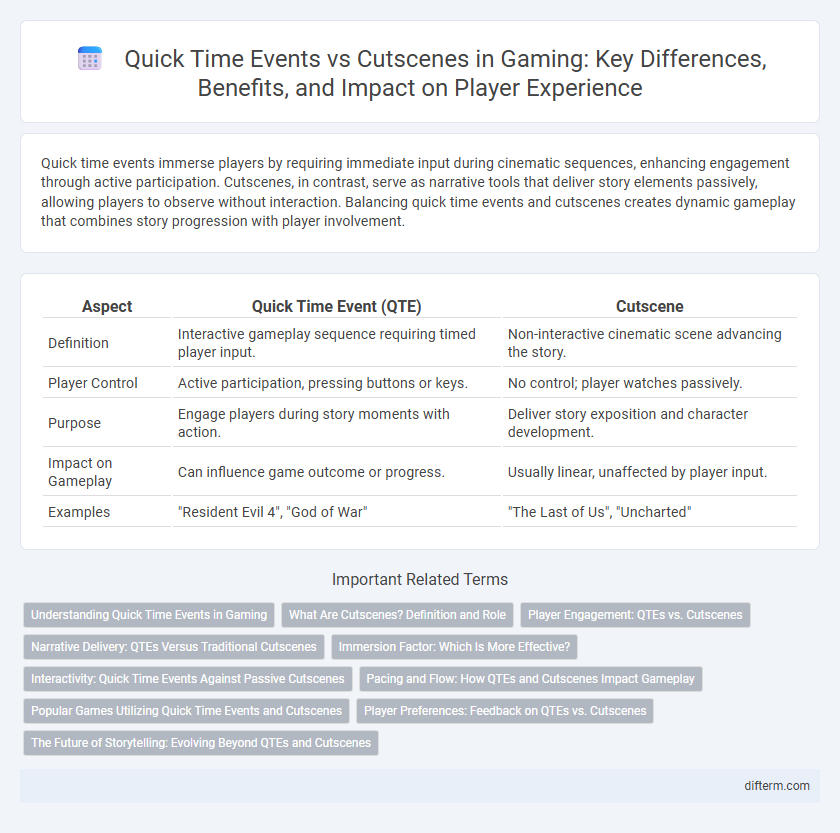Quick time events immerse players by requiring immediate input during cinematic sequences, enhancing engagement through active participation. Cutscenes, in contrast, serve as narrative tools that deliver story elements passively, allowing players to observe without interaction. Balancing quick time events and cutscenes creates dynamic gameplay that combines story progression with player involvement.
Table of Comparison
| Aspect | Quick Time Event (QTE) | Cutscene |
|---|---|---|
| Definition | Interactive gameplay sequence requiring timed player input. | Non-interactive cinematic scene advancing the story. |
| Player Control | Active participation, pressing buttons or keys. | No control; player watches passively. |
| Purpose | Engage players during story moments with action. | Deliver story exposition and character development. |
| Impact on Gameplay | Can influence game outcome or progress. | Usually linear, unaffected by player input. |
| Examples | "Resident Evil 4", "God of War" | "The Last of Us", "Uncharted" |
Understanding Quick Time Events in Gaming
Quick Time Events (QTEs) in gaming require players to respond with specific button presses during cinematic sequences, creating an interactive experience that blends gameplay with narrative. Unlike passive cutscenes, QTEs maintain player engagement by demanding timely reactions, influencing story outcomes and player immersion. This mechanic enhances dynamic storytelling by merging action and cinematic presentation, setting games apart from traditional passive viewing.
What Are Cutscenes? Definition and Role
Cutscenes are scripted sequences in video games that deliver narrative, character development, or exposition without player interaction, enhancing storytelling immersion. These cinematic moments often utilize voice acting, music, and detailed visuals to create emotional impact and advance the plot seamlessly. Unlike quick time events, cutscenes prioritize passive viewing, allowing developers to control pacing and highlight key story points.
Player Engagement: QTEs vs. Cutscenes
Quick Time Events (QTEs) enhance player engagement by requiring active input during critical moments, maintaining immersion and increasing tension. Cutscenes provide narrative depth and visual storytelling but often pause interactivity, potentially reducing player involvement. Integrating QTEs within cutscenes can balance narrative delivery while keeping players engaged through interactive cinematic experiences.
Narrative Delivery: QTEs Versus Traditional Cutscenes
Quick Time Events (QTEs) enhance narrative delivery by actively engaging players, requiring timely inputs that influence story progression and character outcomes. Traditional cutscenes provide a controlled, cinematic experience, ensuring consistent storytelling and emotional impact through pre-rendered visuals and scripted dialogue. Combining QTEs and cutscenes allows developers to balance player agency with immersive, polished narrative moments.
Immersion Factor: Which Is More Effective?
Quick time events (QTEs) enhance immersion by requiring player interaction during critical moments, maintaining engagement and a sense of control. Cutscenes, while visually impactful and narrative-driven, risk breaking immersion by shifting the player into a passive viewing role. Studies show that games incorporating well-designed QTEs tend to keep players more psychologically involved compared to those relying heavily on cutscenes.
Interactivity: Quick Time Events Against Passive Cutscenes
Quick Time Events (QTEs) heighten player engagement by requiring timely inputs during cinematic sequences, blending gameplay with narrative. Unlike passive cutscenes, which deliver story content without user interaction, QTEs maintain interactivity, making players feel integral to the unfolding action. This dynamic approach enhances immersion and can influence story outcomes, contrasting with the linear experience of traditional cutscenes.
Pacing and Flow: How QTEs and Cutscenes Impact Gameplay
Quick Time Events (QTEs) maintain gameplay pacing by actively engaging players in scripted sequences, preventing interruptions and preserving flow. Cutscenes, while enhancing narrative depth, often pause player control, potentially disrupting immersion and slowing momentum. Balancing QTEs and cutscenes is crucial for seamless gameplay experience, ensuring story progression without sacrificing player agency.
Popular Games Utilizing Quick Time Events and Cutscenes
Popular games like Resident Evil 4 and God of War integrate quick time events (QTEs) to maintain player engagement during intense sequences. Titles such as The Last of Us and Red Dead Redemption 2 leverage cinematic cutscenes to deliver immersive storytelling and character development. Both techniques enhance gameplay experience by balancing interactive moments with narrative depth in AAA and indie game titles.
Player Preferences: Feedback on QTEs vs. Cutscenes
Players often prefer quick time events (QTEs) for their interactive engagement, as these sequences maintain player involvement by requiring timely inputs, enhancing immersion. In contrast, cutscenes are frequently criticized for disrupting gameplay flow, providing a more passive narrative experience that can feel tedious or disconnected from player agency. Feedback from gaming communities highlights a preference for balanced integration, where QTEs complement storytelling without overwhelming the core gameplay.
The Future of Storytelling: Evolving Beyond QTEs and Cutscenes
The future of storytelling in gaming is shifting towards more immersive and player-driven narratives that transcend traditional Quick Time Events (QTEs) and cutscenes. Advanced AI and real-time rendering technologies enable dynamic story adaptations based on player choices, fostering deeper emotional engagement. This evolution emphasizes seamless integration between gameplay and narrative, making player agency a core component of storytelling innovation.
quick time event vs cutscene Infographic

 difterm.com
difterm.com